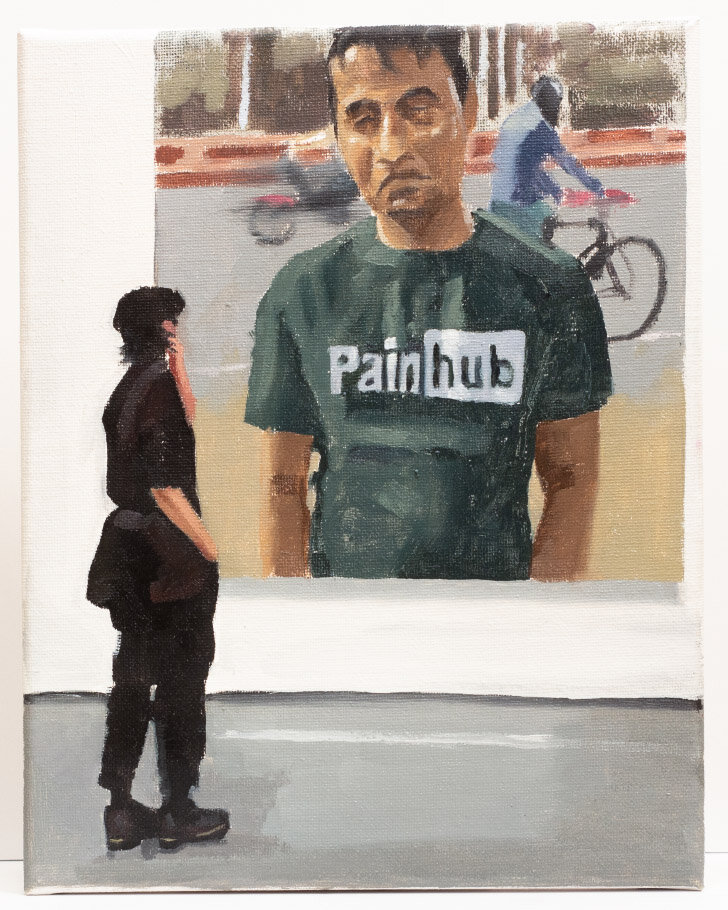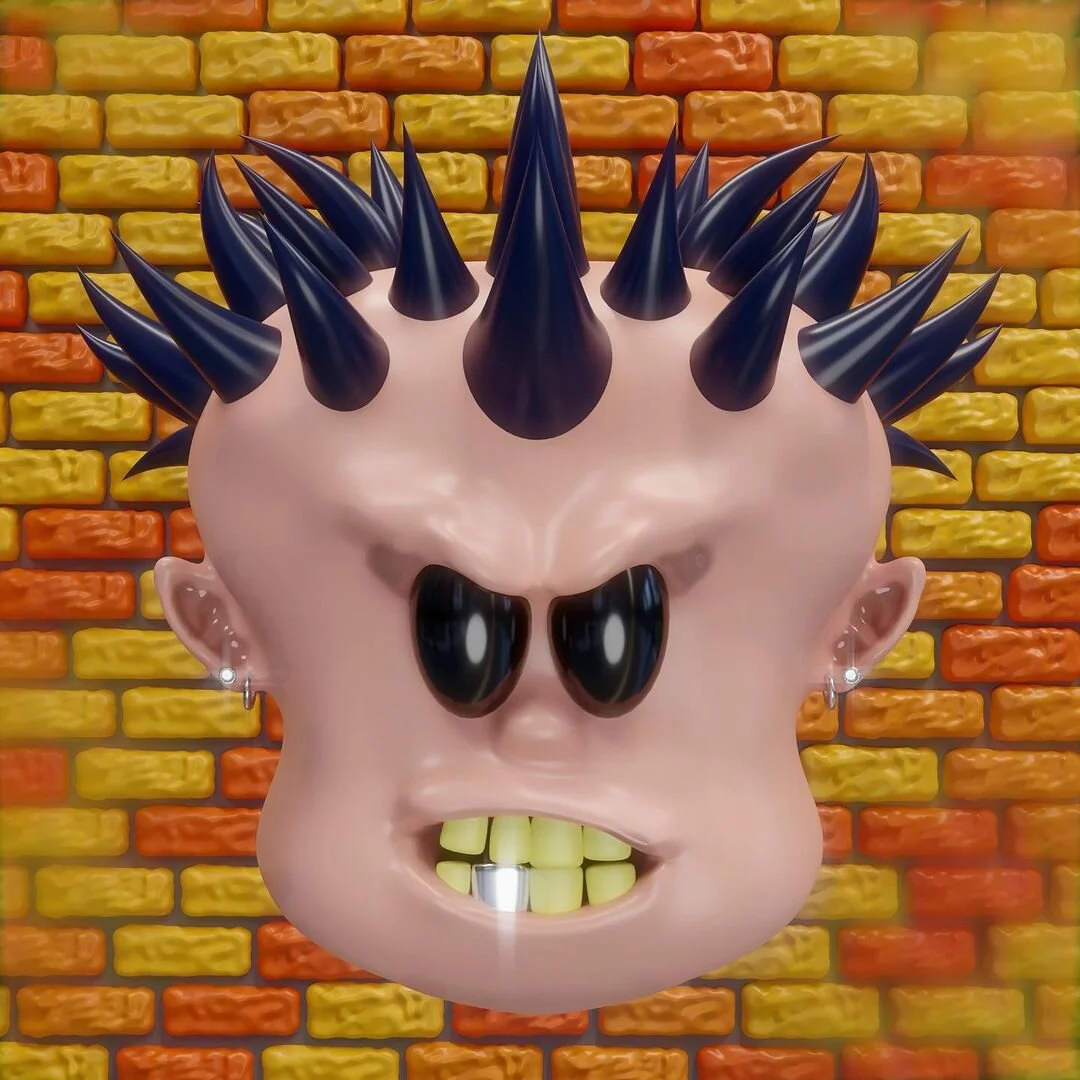Mauro C. Martinez
Situating himself midway between historian and iconoclast, painter Mauro C. Martinez compares the conventions residing in viral memes, cursed images, and traditional oil painting to challenge assumptions on those seemingly antipodal methods of image-making. His work draws from a library of selected images in constant flow – settings like backyards, domestic interiors or digital landscapes become the places where our collective daily dramas unfold. Imbuing the commonplace with novelty, Mauro acknowledges the endless flux of meaning that defines his source material as a medium in itself, as his work often follows a similar course. Mauro’s practice is functional to the image itself, and the consistent adjustment of tools and techniques are the fertile ground where his work finds room to evolve. His paintings operate as solutions to specific problems: this leads him to contextualize each piece as a singular entity – an individual, genuine response to a question. However, it’s over time that the why behind his works is truly revealed.
In one of your recent posts, you spoke about the twofold challenge of working with memes, their infinite mash-ups and many subgenres – a confrontation that is both technical and ideological. What was the impetus that led you to engage with fast, ephemeral and mundane content, to slow it down and contextualize it by using a traditional medium?
I began using these images for a few reasons. With memes in particular, I was intrigued by their inherent properties: they are quickly made, somewhat crude, critical yet categorically non-serious, and have a great viral potential. Shortly after, I discovered the realm of cursed images: the internet’s own brand of imagery that promotes low-resolution, authorless photos that are both seated in our time yet eerily without context. There is a stark contrast between these properties and those of the world of traditional oil painting; the marriage of the two has been a way to compare their conventions and challenge the assumptions about these seemingly opposed modes of image making. I utilize their inherent humor as a vehicle and have been able to disarm and engage my audience in a very novel way.
The reality depicted by your source material is often a representation of domestic circumstances, violent accidents, or fragments of daily life. Can you speak about your criteria for selection?
Sometimes there’s a feeling of familiarity— not like deja vu— but a quintessential quality that makes the image feel like a cross section of our collective daily drama. The good and the bad. Their settings, be it backyards, domestic interiors, or digital landscapes, are the stages upon which these dramas unfold. I also rely heavily on the internet’s algorithmic selection process, where the most highly resonate images climb to the surface. I keep this library of selected images on my phone which is constantly revised and edited.
What’s your relationship to the transience – or loss – of meaning inherent in the aesthetic realities we consume everyday?
Things lose consideration once they become convention. Viewers see a “sensitive content” filter over a potentially offensive image on Instagram and press a button to reveal the image. Rendering this filter as a permanently static painting highlights the previously unconsidered relationship between the image and the viewer. In this way, I am able to imbue the commonplace with novelty. It has been interesting to observe the work itself navigate a viral trajectory. A select few images are being widely re-posted: increasingly without credit as the admins of the accounts lose touch with the source. Whereas most artists might feel rightfully indignant about this situation, I see this loss of “authorship” as simply a necessary byproduct of its viral movement through digital space. For me, the constant flux of meaning becomes a medium in itself.
You work with several techniques, as well as a variety of painting styles and formats. Some of them are starkly reminiscent of their source material, while others seem to evoke a proximity to the history of painting. I’d like to learn more on your method for developing a vision across such an eclectic and, in a way, time-sensitive range of forms, both practically and conceptually.
Every decision I make is in service to the image itself. Technical and stylistic choices are dictated by the content. With the sensitive content paintings, for example, I knew I needed a blurred image, which I could achieve with the airbrush. The clean text overlay was more of a challenge as the text is fine and precise. After a few failed attempts at rendering it by hand, I found that I could easily silkscreen the text over the blurred painting. Cursed Images — crude and often lacking in resolution — require a slightly more painterly hand. Information is rendered quickly, but with accuracy. This constant adjustment of tool and technique, while primarily serving to solve the problem at hand, also becomes fertile ground for new discovery.
There’s also an emphasis on the importance of the process throughout your practice. It seems to be a factor that stands out in the finished work itself, as well as in the way you present your work. How did you get there, and what has that taught you?
Much of the why behind my paintings come to me in hindsight — sometimes my intentions are discovered throughout the process or even long after the painting is finished. Focusing on process is a way to ensure that I’m responding to each painting on its own terms, creating authentic solutions to the problems that occur. Process and documentation have always been important to me, and a big lesson I’m continually learning is to give myself permission to make and be divorced from the outcome. To maintain my practice as a serious habit, but not take myself seriously. As a painter, the best place for me to be is somewhere between historian and iconoclast.
courtesy MAURO C. MARTINEZ
interview VERONICA GISONDI
What to read next


















